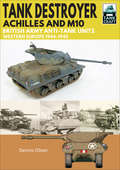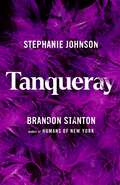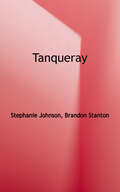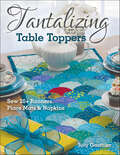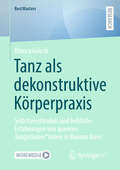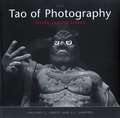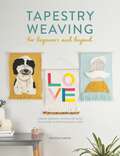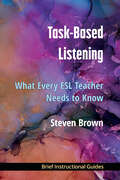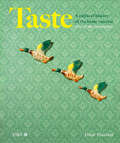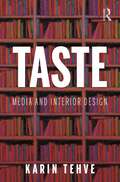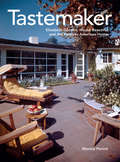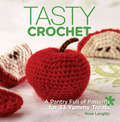- Table View
- List View
Tank Destroyer, Achilles and M10: British Army Anti-Tank Units, Western Europe, 1944–1945 (TankCraft)
by Dennis OliverA guide that blends the history behind this British World War II tank with resources for military vehicle modeling enthusiasts. In this heavily illustrated volume in the TankCraft series Dennis Oliver focuses on the Achilles—the British variant of the American M10—which was one of the most important Allied tank destroyers of the Second World War. It played a key role in the armored battles fought on the Western Front, in particular in France, the Low Countries, Germany and Italy. Built on an adapted Sherman chassis, with sloped armor, an open-topped turret and powerful 17-pounder gun, it was designed to counter the threat posed by the formidable panzers deployed by the German army toward the end of the conflict, in particular the Panther and Tiger tanks. The book covers the design and operational history of the Achilles in close detail, using rare archive photographs and meticulously researched color illustrations, as well as a detailed, authoritative text. A key section displays available model kits and aftermarket products, complemented by a gallery of beautifully constructed and painted models in various scales. Technical details as well as modifications introduced during production and in the field are also examined providing everything the modeler needs to recreate an accurate representation of these historic armored fighting vehicles. Praise for Tank Destroyer, Achilles and M10 &“Covers the design and operational history of the Achilles in close detail, using rare archive photographs and meticulously researched color illustrations, as well as a detailed, authoritative text.&” —Military Vehicles &“Gamers will find this book a useful reference and painting guide.&” —The Miniatures Page
Tanks on the Somme: From Morval to Beaumont Hamel
by Trevor PidgeonOn 15 September 1916 during the Battle of the Somme, tanks - one of the decisive weapons of twentieth-century warfare - were sent into action for the first time. In his previous books Trevor Pidgeon, one of the leading authorities on the early tanks, has told the story of that memorable day, but only now has his account of later tank operations during the Somme battle become available. In this, his last work which was completed shortly before he died, he reconstructs the tank actions that took place between late September and November when the Somme offensive was closed down. His account gives a vivid insight into the actions and experiences of the tank crews, and it shows the appalling dangers they faced as they maneuvered their crude, vulnerable and unreliable machines towards the enemy. His book will be essential reading for anyone who is familiar with his previous studies of the subject and for anyone who wants to follow in the tracks of the tanks as they lumbered across the battlefield nearly 100 years ago.
Tanqueray
by Stephanie Johnson Brandon StantonThe storytelling phenomenon Humans of New York and its #1 bestselling books have captivated a global audience of millions with personal narratives that illuminate the human condition. But one story stands apart from the rest...She is a woman as fabulous, unbowed, and irresistible as the city she lives in. Meet TANQUERAY.In 2019, Humans of New York featured a photo of a woman in an outrageous fur coat and hat she made herself. She instantly captured the attention of millions. Her name is Stephanie Johnson, but she’s better known to HONY followers as “Tanqueray,” a born performer who was once one of the best-known burlesque dancers in New York City. Reeling from a brutal childhood, immersed in a world of go-go dancers and hustlers, dirty cops and gangsters, Stephanie was determined to become the fiercest thing the city had ever seen. And she succeeded.Real, raw, and unapologetically honest, this is the full story of Tanqueray as told by Brandon Stanton—a book filled with never-before-told stories of Tanqueray's struggles and triumphs through good times and bad, personal photos from her own collection, and glimpses of New York City from back in the day when the name “Tanqueray” was on everyone’s lips.
Tanqueray
by Stephanie Johnson Brandon Stanton"A deeply touching memoir . . . A beautiful, sometimes shocking NC-17 story, kept out of the lily-white, upper crust canon of literature--until now."" --The Washington Post The storytelling phenomenon Humans of New York and its #1 bestselling books have captivated a global audience of millions with personal narratives that illuminate the human condition. But one story stands apart from the rest... She is a woman as fabulous, unbowed, and irresistible as the city she lives in. Meet TANQUERAY. In 2019, Humans of New York featured a photo of a woman in an outrageous fur coat and hat she made herself. She instantly captured the attention of millions. Her name is Stephanie Johnson, but she's better known to HONY followers as ""Tanqueray,"" a born performer who was once one of the best-known burlesque dancers in New York City. Reeling from a brutal childhood, immersed in a world of go-go dancers and hustlers, dirty cops and gangsters, Stephanie was determined to become the fiercest thing the city had ever seen. And she succeeded. Real, raw, and unapologetically honest, this is the full story of Tanqueray as told by Brandon Stanton--a book filled with never-before-told stories of Tanqueray's struggles and triumphs through good times and bad, personal photos from her own collection, and glimpses of New York City from back in the day when the name "Tanqueray" was on everyone's lips."
Tansu: Traditional Japanese Cabinetry
by Ty Heineken Kiyoko HeinekenTansu, the unique cabinetry of Japan, springs from a rich folk-art tradition. This book is lavishly illustrated with 27 full-color plates and over 260 monochrome photographs of spectacular chests and elegant details. It is divided into two parts, the first on history and the second on techniques. It also includes an invaluable guide to purchasing and conserving tansu.
Tantalizing Table Toppers: Sew 20+ Runners, Place Mats & Napkins
by Judy GauthierDinner is served! Table decor to enjoy all year A well-dressed table is just stitches away! Showcase your creativity with handmade table toppers that are equal parts functional and fun. Best-selling author Judy Gauthier shares twenty unique table runners you can display year round, plus coordinating placemats and napkins. Step-by-step instructions are included for each project, with basics on piecing, pressing, and understanding color values. Use the coordinating fast2cut Simple Square Templates for easy blocks that fit together like magic! Try out new patchwork, appliqué, and quilting designs before making a commitment to a full quilt. Makers of all skill levels will love the satisfaction of a quick finish. Table accents for every home! Make dinnertime feel special with a quilted runner Instantly change the look of your kitchen or dining room with over twenty fast, fun, and easy projects Share the love—table decor makes great gifts!
Tanz als dekonstruktive Körperpraxis: Selbstverständnis und leibliche Erfahrungen von queeren Tangotänzer*innen in Buenos Aires (BestMasters)
by Bianca GriechIn der kulturellen Praxis des Tango Argentino wird die Semantik einer Überschneidung hegemonialer Diskurse sichtbar, die insbesondere durch binäre Geschlechterrollen und heteronormative Performanz gekennzeichnet sind. Im Kontext der leidenschaftlichen und emotionalen Begegnungen des Tangos, die nicht selten von erotischen Spannungen durchzogen sind, entfaltet sich ein Diskurs, der die heteronormative Konstruktion der tanzenden Körper vermittelt. Ausgehend von der Betrachtung des Tangos als Bewegungspraxis, die in einem symbolisch-diskursiven Feld verortet ist, das den Konstitutionsrahmen für Körper und deren Bewegungen im Tanz schafft, untersucht die vorliegende Arbeit vor dem Hintergrund der Queer Theory und Ansätzen der feministischen Phänomenologie das Verhältnis zwischen dem Diskurs der Geschlechterdifferenz und der körperlich-leiblichen Erfahrung queerer Tangotänzer*innen. Im Zentrum steht dabei die Frage, auf welche Weise heteronormative Strukturen, die in der Tangokultur vorherrschen, im Sinne queerer Subversion dekonstruiert werden. Das Erkenntnisinteresse dieser Arbeit liegt darin zu verstehen, wie sich queeres Selbstverständnis im Tango manifestiert, in welchen Elementen des Tangos sich Performativität und die diskursive Konstitution von Geschlechterrollen widerspiegeln und wie queere Tangotänzer*innen in Bezug darauf den Tanz auf der körperlichen Ebene erfahren.
Tao of Photography: Seeing Beyond Seeing
by Philippe L. Gross S. I. ShapiroThis provocative, visually stunning volume draws upon Taoist teachings to explore the creative and spiritual dimensions of the art of photography. Excerpts from the Taoist classic the Chuang-tzu and the writings of Western aesthetes are complemented by over 60 photographs from the work of such canonical photographers as Henri Cartier-Bresson, Alfred Stieglitz, and Dorothea Lange. Lucid instructional text and enlightening exercises assure that photographers of all levels will be able to incorporate the lessons of the Tao into their own work.
Taos
by Lyn Bleiler Society of the Muse of the SouthwestLocated in the "Land of Enchantment," Taos has a long history that predates the Pilgrims' arrival at Plymouth Rock. Anasazi Indians first inhabited the Taos Valley in 1000 A.D., and the Taos Pueblo (both a UNESCO World Heritage Site and a National Historic Landmark) has been continuously inhabited for more than 1,000 years. Spanish conquistadors explored Taos in 1540, and by 1615 many Spanish families had settled in the region. Taos later became a crossroads for French and American trappers, and by the early 1800s it was a bustling headquarters for mountain men, including the legendary Kit Carson. When artists Bert Phillips and Ernest Blumenschein passed through in 1898, a broken wagon wheel delayed them and ultimately resulted in another wave of newcomers, who established an art colony. In 1917, New York socialite Mabel Dodge became enthralled with Taos, and during the next four decades she invited many highly regarded creative people to visit, including Ansel Adams, Carl Jung, Georgia O'Keefe, Willa Cather, D. H. Lawrence, and Aldous Huxley. Taos continues to attract adventurous, spirited individuals.
Tapestry Conservation: Principles and Practice
by Maria Hayward Frances LennardTapestry Conservation: Principles and Practice explores current practice and recent research in tapestry conservation, promoting awareness of recent developments among conservators and custodians of tapestries. The book facilitates more informed conservation practice and decision-making, and helps custodians to select the most appropriate method of intervention.
Tapestry Design Basics and Beyond: Planning and Weaving with Confidence
by Tommye McClure ScanlinRenowned master weaver Tommye McClure Scanlin offers more than 60 step-by-step "explorations" that lead you from understanding design concepts to using them on your loom. “I wish Tommye’s book had been available when I was first struggling with creating my own designs . . . There is no person more qualified to teach these ideas than Tommye Scanlin.” —Rebecca Mezoff, foreword Once ideas and images come to mind, the next step in weaving your tapestry—interpreting these into effective compositions—may be challenging. Learn here, in ways that relate specifically to tapestry art, the design basics you need to make your best work. A master weaver offers more than 60 step-by-step "explorations" that lead you from understanding design concepts in your head to using them on your loom. Be inspired to explore "weavable" ways to manage line, shape, color, texture, emphasis, balance, rhythm, and more for results that bring your tapestries to a new level. In Part 1, dive into the fundamentals of design. Parts 2 and 3 hold explorations—exercises with a tapestry twist. Part 4 teaches ways to turn designs into cartoons. A resource treasure trove offers ideas for finishing tapestries (essential to the design's completeness), helpful templates, glossaries, and other core information to carry forward on your creative path. “Clear explanations . . . scores of inspiring tapestries . . . Suggestions for finding design ideas, as well as developing, and assessing them, will be of value to all. Bravo!” —Mary Lane, former executive director, American Tapestry Alliance
Tapestry Weaving for Beginners and Beyond: Create Graphic Woven Art with this Guide to Painting with Yarn
by Kristin CarterLearn to weave your own stories and create custom-made, grammable woven wall art with this guide to tapestry weaving.Here you’ll find the basic techniques for tapestry weaving including a quick and easy way to make your own loom using an old photo frame, how to choose the right yarn, working with a template and how to start off a weave. Author Kristin Carter then explores all the tapestry weaving techniques you will need to make your own stunning wall hangings. All of these techniques are accompanied by step-by-step photography so the instructions are super clear and suitable for absolute beginners. Learn how to do rya loops, weft facing weaving, soumak, pile weaving, diamond twill, overweaving, boubles, and an inverted rya fringe.There are seventeen incredible projects for you to experiment and try out your new skills. Each of these can be adapted in order to create your own personalized wall hangings so you can make special heirloom woven art for friends and family. All of the projects are suitable for a an A3 sized loom so you only need one size to try out all of the variations.There are projects for abstract patterns, gradient weaving, blending compatible yarns, pet and people portraits with special techniques for recreating the texture of fur and hair, how to play with transparency in a weaving and creating texture using different yarns. Other techniques covered include cartooning (how to make a cartoon template from photographs); creating templates from your own sketches, how to create a marble effect and advice about color theory and weaving.
Tapestry Weaving: A Comprehensive Study Guide
by Nancy HarveyIt's easy to learn tapestry weaving from start to finish with Nancy Harvey, one of America's best-known teachers of this exciting craft. Using the same clear step-by-step approach that makes her workshops so successful, Nancy leads you through building a simple frame loom, to mastering the basic techniques, to completing handsome pieces based on her designs. She even provides tips on how to prepare designs of your own. In this book, you will find: Beginning and intermediate samplers to help you learn the basics Hundreds of highlighted tips for weavers of all levels of experience Six practice designs for building skills Ideas inspiring your own designs, even if you "can't draw" Over 380 illustrations and photographs With hundreds of diagrams, tips, and tapestry designs, Tapestry Weaving: A Comprehensive Study Guide is essential reading for tapestry artists and handweavers alike.
Targeting Zero: Whole Life and Embodied Carbon Strategies for Design Professionals
by Simon SturgisEmbodied and Whole Life Carbon will change the way buildings are designed, yet carbon emissions associated with the construction and life of buildings are not yet wholly understood by the profession. Energy is assumed to be the province of services engineers, yet energy from materials is as big an issue. Architects have the opportunity to take the lead in redefining how buildings are designed to achieve a low carbon future.
Tarpon Springs
by Dolores KilgoTarpon Springs, the South's Mediterranean port city named for the abundant fish found off its coast, is hailed as the "Sponge Capital of the World." The oldest town in Pinellas County, Tarpon is located along the Anclote River where the river flows into the Gulf of Mexico. History in this coastal community dates back to the 1800s with the arrival of the first settlers. The advent of the railroad and the building of the Anclote Key Lighthouse brought many positive changes to the area; wealthy Northerners flocked here creating a winter haven while numerous fishing vessels plied city waters. Enterprising entrepreneurs boosted the city's economy and reputation with the harvesting of sponges. The Greek immigrants who came to the area to continue their traditional trade of sponge diving forever enriched the city's cultural makeup with their families and customs. Today, the progressive community continues to be a shining example of historic preservation and cultural variety. Images of America: Tarpon Springs celebrates the fascinating history of "the Venice of the South" and invites readers to experience this breathtaking locale through words and vintage photographs. Rare images, including scenes of the early sponge divers, businesses, residents, festivals, and celebrations, abound in this unique volume. Natives, visitors, and history buffs alike will delight in this visual tour of a picturesque and historically interesting community.
Tarrytown and Sleepy Hollow in the 20th Century
by Sara Mascia Maryann MarshallLocated just miles north of New York City, the Hudson River villages of Tarrytown and Sleepy Hollow experienced the highs and lows of the 20th century. The villages experienced life in a grand scale from the 1909 Hudson Fulton Celebration to the 1970s village centennial and American bicentennial festivities. Photographs from the collection of the Historical Society, Inc., serving Sleepy Hollow and Tarrytown bring the 20th century to life. Tarrytown and Sleepy Hollow in the 20th Century includes images of local and world-renowned personalities, the changing business landscape, growth and consolidation of the public schools, participation of the local population in various business and social organizations, changes in fashion over the years, and the construction of the Tappan Zee Bridge in the 1950s.
Tashlinesque: The Hollywood Comedies of Frank Tashlin (Wesleyan Film)
by Ethan de SeifeFrank Tashlin (1913–1972) was a supremely gifted satirist and visual stylist who made an indelible mark on 1950s Hollywood and American popular culture—first as a talented animator working on Looney Tunes cartoons, then as muse to film stars Jerry Lewis, Bob Hope, and Jayne Mansfield. Yet his name is not especially well known today. Long regarded as an anomaly or curiosity, Tashlin is finally given his due in this career-spanning survey. Tashlinesque considers the director's films in the contexts of Hollywood censorship, animation history, and the development of the genre of comedy in American film, with particular emphasis on the sex, satire, and visual flair that comprised Tashlin's distinctive artistic and comedic style. Through close readings and pointed analyses of Tashlin's large and fascinating body of work, Ethan de Seife offers fresh insights into such classic films as Will Success Spoil Rock Hunter?, The Girl Can't Help It, Artists and Models, The Disorderly Orderly, and Son of Paleface, as well as numerous Warner Bros. cartoons starring Porky Pig, among others. This is an important rediscovery of a highly unusual and truly hilarious American artist. Includes a complete filmography.
Task-Based Listening (Kindle Single): What Every ESL Teacher Needs to Know
by Steven Brown“I have tried to balance classroom advice with the reasons for the advice, grounded in research evidence. I think it’s important--if you want to grow as a teacher--that you have not only a bag of tricks, but a base from which to discuss your classroom with other teachers.” – Steven Brown This e-single is an introduction to task-based listening for ESL/EFL teachers who are looking for ways to do more in their listening classes than ask students to answer comprehension questions about something they listened to. In this short ebook, Steven Brown, author of Listening Myths: Applying Second Language Research to Classroom Teaching and a well-known ESL/EFL listening textbook series, defines task-based listening (TBL) and describes: how to build a task-based listening program how to create a task-based listening lesson ways to activate vocabulary acquisition in listening tasks how listening can improve grammatical knowledge the links between listening and pronunciation the ways that metacognitive strategies can assist students when listening, particularly when listening to lectures the advantages of extensive listening (especially while reading) the benefits of interactive listening, including how to design a good speaking task All chapters include specific tips and suggestions for using these concepts in the classroom.
Task-Based Listening: What Every ESL Teacher Needs to Know
by Steven BrownAre you looking for activities to use in your listening classes beyond asking students to answer comprehension questions? In Task-Based Listening, author Steven Brown defines task-based listening (TBL) and describes how to build a task-based listening program, how to create a task-based listening lesson, ways to activate vocabulary acquisition and improve grammatical knowledge, and the links between listening and pronunciation. In addition, he covers the ways that metacognitive strategies can assist students when listening, the advantages of extensive listening, and the benefits of interactive listening. Readers will find specific tips and suggestions for using these concepts in the classroom.
Taste: A cultural history of the home interior
by Drew PlunkettDemocratic in intention and approach, the book will argue that the home interior, as independently created by the ‘amateur’ householder, offers a continuous informal critique of shifting architectural styles (most notably with the advent of Modernism) and the design mainstream. Indeed, it will suggest that the popular increasingly exerts an influence on the professional. Underpinned by academic rigour, but not in thrall to it, above all this book is an engaging attempt to identify the cultural drivers of aesthetic change in the home, extrapolating the wider influence of ‘taste’ to a broad audience – both professional and ‘trade’. In so doing, it will explore enthralling territory – money, class, power and influence. Illustrated with contemporary drawings and cartoons as well as photos, the book will not only be an absorbing read, but an enticing and attractive object in itself.
Taste: Media and Interior Design
by Karin TehveThis book traces and explores the evolution of taste from a design perspective: what it is, how it works, and what it does. Karin Tehve examines taste primarily through its recursive relationship to media. This ongoing process changes the relationship between designers and the public, and our understanding of the relationship of individuals to their social contexts. Through an analysis of taste, design is understood to be an active constituent of social life, not as autonomous from it. This book reclaims a term long dismissed from interior design and unveils taste’s role as a powerful social and political agent within systems of aesthetics, affecting both its producers and consumers. Each chapter discusses a taste concept or definition, analyzes its reciprocal relationship with media, and explores its implications for interior design. Illustrated with 70 images, taste’s relationship to media is viewed through a variety of different lenses, including books, photography, magazines, internet, social media and algorithms. Written primarily for students and scholars of interior design and related design fields, this book will be a helpful resource for all those interested in the question of taste, and is an invitation to produce and consume all media critically.
Tastemaker: Elizabeth Gordon, House Beautiful, and the Postwar American Home
by Monica PenickA riveting and superbly illustrated account of the enigmatic House Beautiful editor’s profound influence on mid-century American taste From 1941 to 1964, House Beautiful magazine’s crusading editor-in-chief Elizabeth Gordon introduced and promoted her vision of “good design” and “better living” to an extensive middle-class American readership. Her innovative magazine-sponsored initiatives, including House Beautiful’s Pace Setter House Program and the Climate Control Project, popularized a “livable” and decidedly American version of postwar modern architecture. Gordon’s devotion to what she called the American Style attracted the attention of Frank Lloyd Wright, who became her ally and collaborator. Gordon’s editorial programs reshaped ideas about American living and, by extension, what consumers bought, what designers made, and what manufacturers brought to market. This incisive assessment of Gordon’s influence as an editor, critic, and arbiter of domestic taste reflects more broadly on the cultures of consumption and identity in postwar America. Nearly 200 images are featured, including work by Ezra Stoller, Maynard Parker, and Julius Shulman. This important book champions an often-neglected source—the consumer magazine—as a key tool for deepening our understanding of mid-century architecture and design.
Tastemakers and Tastemaking: Mexico and Curated Screen Violence (SUNY series in Latin American Cinema)
by Niamh ThorntonTastemakers and Tastemaking develops a new approach to analyzing violence in Mexican films and television by examining the curation of violence in relation to three key moments: the decade-long centennial commemoration of the Mexican Revolution launched in 2010; the assaults and murders of women in Northern Mexico since the late 1990s; and the havoc wreaked by the illegal drug trade since the early 2000s. Niamh Thornton considers how violence is created, mediated, selected, or categorized by tastemakers, through the strategic choices made by institutions, filmmakers, actors, and critics. Challenging assumptions about whose and what kind of work merit attention and traversing normative boundaries between "good" and "bad" taste, Thornton draws attention to the role of tastemaking in both "high" and "low" media, including film cycles and festivals, adaptations of Mariano Azuela's 1915 novel, Los de Abajo, Amat Escalante's hyperrealist art films, and female stars of recent genre films and the telenovela, La reina del sur. Making extensive use of videographic criticism, Thornton pays particularly close attention to the gendered dimensions of violence, both on and off screen.
Tasty Crochet: A Pantry Full of Patterns for 33 Tasty Treats
by Rose LanglitzDo you secretly love to play with your food?Whether you're craving peanuts or pizza, you'll find just the thing to hit the spot between the covers of Tasty Crochet. With over 30 crochet patterns on the menu, there's something here to please every palette. In addition to snack items that can be stitched up in a flash, you'll find:patterns to plan a meal for breakfast, lunch, dinner and even dessertbasic crochet techniques to get you started right awayshort "ingredients" lists to make finishing an item quick and easyWhether they're play food for the kids or fun projects for you, you'll love increasing your daily fiber intake with Tasty Crochet!
Tate Create Things to Make & Do (Tate #11)
by Sally TallantCut, cook, draw, dye, dream, snap and spin!Who better to make art with than today's best-loved artists? This absorbing book has been created by a selection of the world's leading contemporary artists and provides projects and activities designed to challenge and expand your approach to making art. You will never again find yourself short of ideas for things to make and do!Make recipes by Olafur Eliasson and listen to how they sound; create a spotty, squirmy salamander with Monster Chetwynd; trace meditative drawings and explore the power of repetition with Yayoi Kusama; build a living collage with Linder; or get stuck into some classic puzzle activities turned on their heads by Jeremy Deller. Each activity draws on the artist's own practice and is supported by guidance and advice from the artists themselves.
